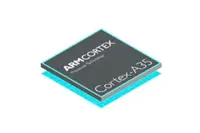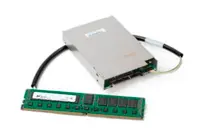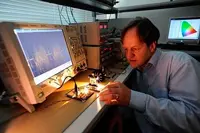Electronics News
Archive : 12 November 2015 год
 CEVA and UltraSoC announced that they have partnered to make UltraSoC’s universal system-on-chip (SoC) debug solution available for CEVA DSP cores.
CEVA and UltraSoC announced that they have partnered to make UltraSoC’s universal system-on-chip (SoC) debug solution available for CEVA DSP cores.
Today’s electronic devices require sophisticated, computationally intensive signal processing algorithms in order to execute audio, voice, vision, image, and communications processing functions. CEVA’s portfolio of signal processing cores and platforms are claimed to be tailored to enable these processor-intensive functions with minimal power consumption, suiting them for smart, connected devices.
UltraSoC’s universal debug solution is said to enable SoC developers to build an on-chip monitoring, control and communications architecture that is said to ‘look inside’ the chip while the device is operating. This assists the identification and elimination of bugs, speeding time to market. It can also be used after deployment for in-field performance monitoring and troubleshooting, leading to enhancements for current and next generation products.
Moshe Shahar, director of DSP Systems Architecture at CEVA, said: “As SoCs increasingly utilise multiple processors, the level of complexity rises accordingly and being able to monitor and analyse the behaviour of an entire device represents a distinct advantage for developers.”
The platform is said to consist of a dual core ARM and CEVA based system in an FPGA, running side-by-side, with the UltraSoC IP, effectively allowing the two processors to be debugged and fine-tuned within a single environment.
Rupert Baines, CEO of UltraSoC, added: “By working together, UltraSoC and CEVA now offer significant benefits to SoC developers who are designing CEVA DSPs into the next generation of emerging smart and connected devices.”
Pic: Rupert Baines, CEO of UltraSoC
Author
Tom Austin-Morgan
Source: www.newelectronics.co.uk
 ARM has launched a new architecture for its M class MCU cores, as well as the first member of a new family of ultra efficient Cortex-A class processors.
ARM has launched a new architecture for its M class MCU cores, as well as the first member of a new family of ultra efficient Cortex-A class processors.
Nandam Nayampally, vp of marketing for ARM’s CPU group, said v8-M is a 32bit architecture which will run the T32/Thumb instruction sets and bring TrustZone levels of security to the M class for the first time. “The requirements will be different,” he said, “so the architecture has been adapted.” Amongst the features will be protected memory and the ability to separate trusted and non trusted data and hardware. ARM also unveiled the AMBA AHB5 bus.
“When you pull it all together,” Nayampally noted, “you have processors optimised for MCU applications, featuring determinism and low latency.”
Meanwhile, the company is also launching the Cortex-A35, which it is aiming at those who would have chosen an A5 or an A7. The core is said to consume 10% less power than a Cortex-A7, but to provide from 6 to 40% more performance. The 64bit capable core is said to consume less than 90mW when running at 1GHz on a 28nm device. Ian Smythe, director of marketing programmes for ARM’s CPU group, said: “We expect that an efficient implementation of the core could cut power consumption to 5 or 6mW at 100MHz.”
The A35 is being targeted at entry level smartphones. Smythe said licences have been signed with ‘multiple customers’, with devices expected by the end of 2016.
Author
Graham Pitcher
Source: www.newelectronics.co.uk
 Micron Technology has introduced its 8GByte DDR4 NVDIMM, the company's first commercially available solution in the persistent memory category. Persistent memory balances latency, bandwidth, capacity and cost, delivering DRAM-like access to critical data and allowing system designers to better manage overall costs.
Micron Technology has introduced its 8GByte DDR4 NVDIMM, the company's first commercially available solution in the persistent memory category. Persistent memory balances latency, bandwidth, capacity and cost, delivering DRAM-like access to critical data and allowing system designers to better manage overall costs.
As data centres evolve to handle the growing influx of data, the cost of moving data and storing it away from the CPU becomes increasingly prohibitive, creating the need for faster, more responsive solutions. Persistent memory allows greater flexibility in data management by providing non-volatile, low latency memory closer to the processor. With NVDIMM technology, Micron says it can deliver a persistent memory solution capable of meeting many of today's biggest computing challenges.
Tom Eby, vice president for Micron's compute and networking business unit, said:"Micron is delivering on the promise of persistent memory with a solution that gives system architects a new approach for designing systems with better performance, reduced energy usage and improved total cost of ownership."
Micron's NVDIMM technology is a non-volatile solution that combines NAND flash reliability, DRAM performance and an optional power source into a single memory subsystem, delivering a powerful solution that ensures data stored in memory is protected against power loss. By placing non-volatile memory on the DRAM bus, this architecture allows customers to store data close to the processor and optimise data movement by delivering faster access to variables stored in DRAM.
The NVDIMM technology is suitable for applications such as big data analytics, storage appliances, RAID cache, In-Memory Databases and On Line Transaction Processing.
Author
Tom Austin-Morgan
Source: www.newelectronics.co.uk
 Solar panels can not only be used to power data communication systems, but may also be able to act as broadband receivers. The idea has been developed by Edinburgh University’s LiFi R&D centre and spin off pureLiFI, who also suggest that smart watches might be powered and connected to the internet using light.
Solar panels can not only be used to power data communication systems, but may also be able to act as broadband receivers. The idea has been developed by Edinburgh University’s LiFi R&D centre and spin off pureLiFI, who also suggest that smart watches might be powered and connected to the internet using light.
Tom Higgison, IP project manager with Edinburgh Research and Innovation, said: “This technology combines light based data communications with energy harvesting to create an exciting set of applications not previously anticipated, including rural broadband access, smart city networks and the Internet of Things. The wider opportunity is to transform global communications by speeding the process of bringing internet and other data communication functionality to remote and poorer regions in a way not previously thought achievable due to lack of infrastructure and investment.”
The approach builds on work performed at Edinburgh by Professor Harald Haas, pictured. He said: “The potential expansion to the internet is massive and my aspiration is that this broadband solar panel receiver technology for Li-Fi will help solve the challenges of the digital divide throughout the world and catalyse the uptake of the IoT, as connectivity and battery-free power supplies are essential if we want to connect 1trillion objects to the internet.”
Author
Graham Pitcher
Source: www.newelectronics.co.uk

